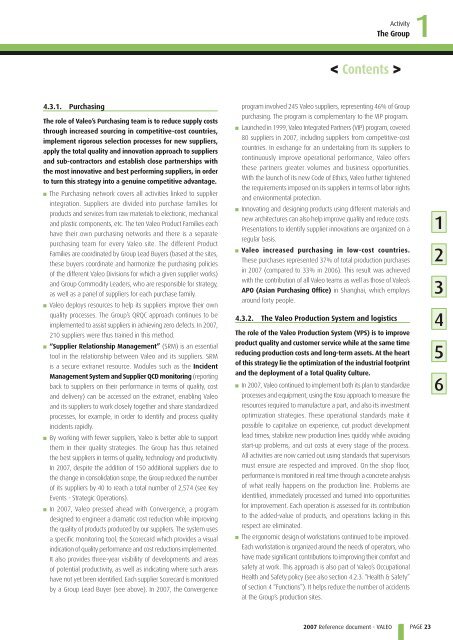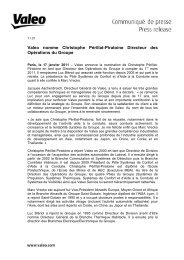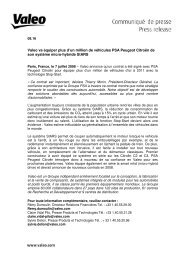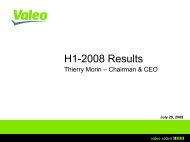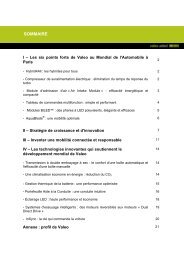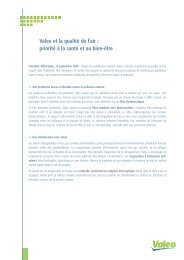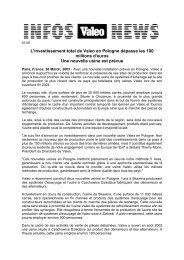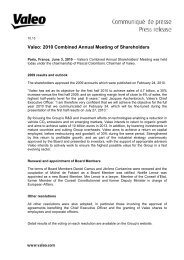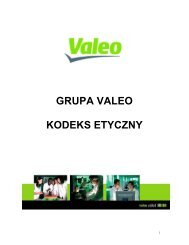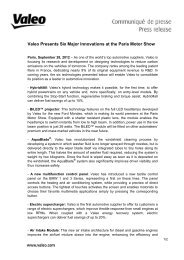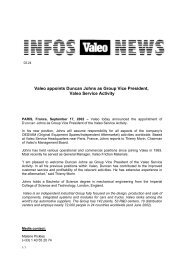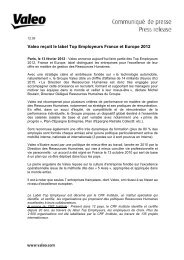2007 Reference document (PDF) - Valeo
2007 Reference document (PDF) - Valeo
2007 Reference document (PDF) - Valeo
You also want an ePaper? Increase the reach of your titles
YUMPU automatically turns print PDFs into web optimized ePapers that Google loves.
4.3.1. Purchasing<br />
The role of <strong>Valeo</strong>’s Purchasing team is to reduce supply costs<br />
through increased sourcing in competitive-cost countries,<br />
implement rigorous selection processes for new suppliers,<br />
apply the total quality and innovation approach to suppliers<br />
and sub-contractors and establish close partnerships with<br />
the most innovative and best performing suppliers, in order<br />
to turn this strategy into a genuine competitive advantage.<br />
■<br />
■<br />
■<br />
■<br />
■<br />
The Purchasing network covers all activities linked to supplier<br />
integration. Suppliers are divided into purchase families for<br />
products and services from raw materials to electronic, mechanical<br />
and plastic components, etc. The ten <strong>Valeo</strong> Product Families each<br />
have their own purchasing networks and there is a separate<br />
purchasing team for every <strong>Valeo</strong> site. The different Product<br />
Families are coordinated by Group Lead Buyers (based at the sites,<br />
these buyers coordinate and harmonize the purchasing policies<br />
of the different <strong>Valeo</strong> Divisions for which a given supplier works)<br />
and Group Commodity Leaders, who are responsible for strategy,<br />
as well as a panel of suppliers for each purchase family.<br />
<strong>Valeo</strong> deploys resources to help its suppliers improve their own<br />
quality processes. The Group’s QRQC approach continues to be<br />
implemented to assist suppliers in achieving zero defects. In <strong>2007</strong>,<br />
210 suppliers were thus trained in this method.<br />
“Supplier Relationship Management” (SRM) is an essential<br />
tool in the relationship between <strong>Valeo</strong> and its suppliers. SRM<br />
is a secure extranet resource. Modules such as the Incident<br />
Management System and Supplier QCD monitoring (reporting<br />
back to suppliers on their performance in terms of quality, cost<br />
and delivery) can be accessed on the extranet, enabling <strong>Valeo</strong><br />
and its suppliers to work closely together and share standardized<br />
processes, for example, in order to identify and process quality<br />
incidents rapidly.<br />
By working with fewer suppliers, <strong>Valeo</strong> is better able to support<br />
them in their quality strategies. The Group has thus retained<br />
the best suppliers in terms of quality, technology and productivity.<br />
In <strong>2007</strong>, despite the addition of 150 additional suppliers due to<br />
the change in consolidation scope, the Group reduced the number<br />
of its suppliers by 40 to reach a total number of 2,574 (see Key<br />
Events - Strategic Operations).<br />
In <strong>2007</strong>, <strong>Valeo</strong> pressed ahead with Convergence, a program<br />
designed to engineer a dramatic cost reduction while improving<br />
the quality of products produced by our suppliers. The system uses<br />
a specific monitoring tool, the Scorecard which provides a visual<br />
indication of quality performance and cost reductions implemented.<br />
It also provides three-year visibility of developments and areas<br />
of potential productivity, as well as indicating where such areas<br />
have not yet been identified. Each supplier Scorecard is monitored<br />
by a Group Lead Buyer (see above). In <strong>2007</strong>, the Convergence<br />
■<br />
■<br />
■<br />
<strong>2007</strong> <strong>Reference</strong> <strong>document</strong> - VALEO<br />
Activity<br />
The Group<br />
program involved 245 <strong>Valeo</strong> suppliers, representing 46% of Group<br />
purchasing. The program is complementary to the VIP program.<br />
Launched in 1999, <strong>Valeo</strong> Integrated Partners (VIP) program, covered<br />
80 suppliers in <strong>2007</strong>, including suppliers from competitive-cost<br />
countries. In exchange for an undertaking from its suppliers to<br />
continuously improve operational performance, <strong>Valeo</strong> offers<br />
these partners greater volumes and business opportunities.<br />
With the launch of its new Code of Ethics, <strong>Valeo</strong> further tightened<br />
the requirements imposed on its suppliers in terms of labor rights<br />
and environmental protection.<br />
Innovating and designing products using different materials and<br />
new architectures can also help improve quality and reduce costs.<br />
Presentations to identify supplier innovations are organized on a<br />
regular basis.<br />
<strong>Valeo</strong> increased purchasing in low-cost countries.<br />
These purchases represented 37% of total production purchases<br />
in <strong>2007</strong> (compared to 33% in 2006). This result was achieved<br />
with the contribution of all <strong>Valeo</strong> teams as well as those of <strong>Valeo</strong>’s<br />
APO (Asian Purchasing Office) in Shanghai, which employs<br />
around forty people.<br />
4.3.2. The <strong>Valeo</strong> Production System and logistics<br />
The role of the <strong>Valeo</strong> Production System (VPS) is to improve<br />
product quality and customer service while at the same time<br />
reducing production costs and long-term assets. At the heart<br />
of this strategy lie the optimization of the industrial footprint<br />
and the deployment of a Total Quality Culture.<br />
■<br />
■<br />
< Contents ><br />
In <strong>2007</strong>, <strong>Valeo</strong> continued to implement both its plan to standardize<br />
processes and equipment, using the Kosu approach to measure the<br />
resources required to manufacture a part, and also its investment<br />
optimization strategies. These operational standards make it<br />
possible to capitalize on experience, cut product development<br />
lead times, stabilize new production lines quickly while avoiding<br />
start-up problems, and cut costs at every stage of the process.<br />
All activities are now carried out using standards that supervisors<br />
must ensure are respected and improved. On the shop floor,<br />
performance is monitored in real time through a concrete analysis<br />
of what really happens on the production line. Problems are<br />
identified, immediately processed and turned into opportunities<br />
for improvement. Each operation is assessed for its contribution<br />
to the added-value of products, and operations lacking in this<br />
respect are eliminated.<br />
The ergonomic design of workstations continued to be improved.<br />
Each workstation is organized around the needs of operators, who<br />
have made significant contributions to improving their comfort and<br />
safety at work. This approach is also part of <strong>Valeo</strong>’s Occupational<br />
Health and Safety policy (see also section 4.2.3. “Health & Safety”<br />
of section 4 “Functions”). It helps reduce the number of accidents<br />
at the Group’s production sites.<br />
1<br />
PAGE 23<br />
1<br />
2<br />
3<br />
4<br />
5<br />
6


